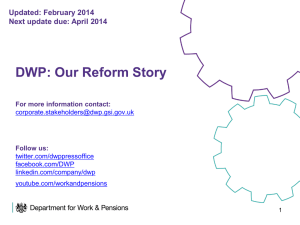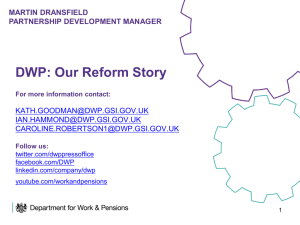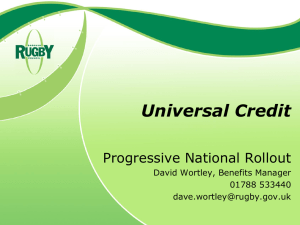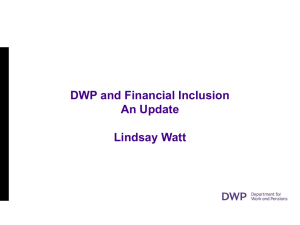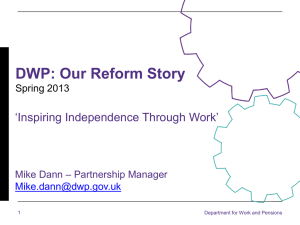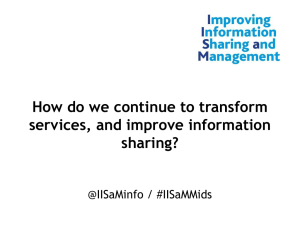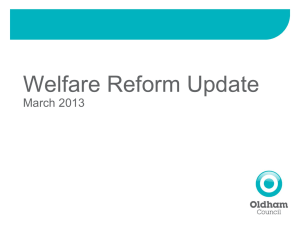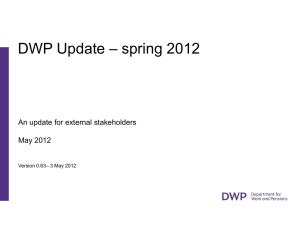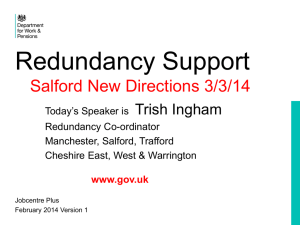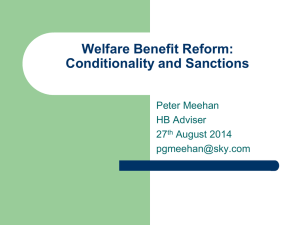Jennifer Bradley - Industrial Communities Alliance
advertisement
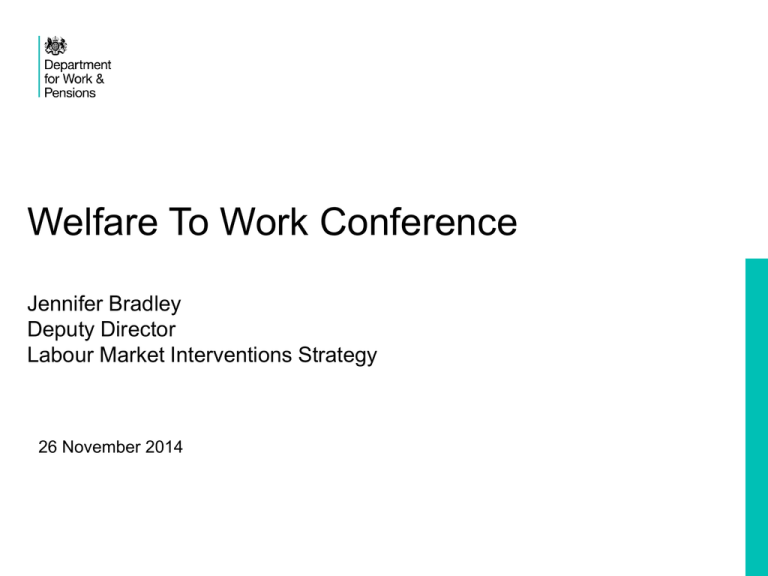
Welfare To Work Conference Jennifer Bradley Deputy Director Labour Market Interventions Strategy 26 November 2014 DWP: Drivers of Reform • Tackle Welfare Dependency. Previous system trapped people into welfare dependency with 1.9 million children living in homes where no-one has a job and 297,000 households where no one has ever worked • Improve work incentives. Benefits system created little incentive to work, and tens of thousands were left on incapacity benefit for more than a decade • Put public spending on a more sustainable footing. As part of the Government’s long term economic plan, reforms are fixing the welfare system to ensure it promotes work, helps people lift themselves out of poverty Department for Work & Pensions 2 Welfare Reform – Social Justice The Government’s approach to welfare reform is underpinned by the values of Social Justice – understanding and tackling the root causes of poverty rather than their symptoms. It is based on ensuring that the most disadvantaged in society have the tools they need to transform their lives, and the lives of their families, and to realise their potential Social Justice principles underpin and link all aspects of our work and reforms - influencing our overall direction, our policies, and the delivery of DWP services. Examples of what we have introduced include: • New Domestic Violence legislation • Day 1 access to the Work Programme for ex-offenders • Easements to job search activity for those on recognised drug/alcohol treatment programmes • Trialling different approaches to those in entrenched worklessness. Department for Work & Pensions 3 Welfare Reform – So far Automatic enrolment • Already enrolled 4 million people in workplace pensions • Rolled out to all firms with more than 250 employees • Now rolling out to those with between 50 - 249 employees Child maintenance • Gone live with charging process • Started case closure (13k letters a week) Universal Credit • In 98 jobcentres by Christmas, for singles and couples – families roll out announced, and testing a digital service in Sutton Labour Market Reforms • Asking more of claimants from the outset of a claim though with more tailored support. Department for Work & Pensions 4 Employment Support Significant changes have been made to the welfare-to-work programmes available to Jobcentre Plus claimants. Changes include: • Universal Jobmatch, an online job posting and matching service for both employer / recruiters and jobseekers. • Youth Contract (including the Wage Incentive) is a programme designed to get more young people into meaningful employment, training or work experience. • The New Enterprise Allowance (NEA) helps unemployed people who want to start their own business. It provides access to business mentoring and financial support. • Spending Review 2013 measures – since April 2014, pre-Work Programme Jobseeker's Allowance claimants and certain lone parents and responsible carers are subject to a number of measures which increase conditionality and support. Help- to- Work measures for those returning from the WP. Department for Work & Pensions 5 5 Employment Support • Freedoms and Flexibilities was implemented in April 2012. All Work Services Districts have been given local autonomy to tailor their back-towork services to meet the needs of individual claimants and local labour markets. • Work Programme offers greater freedom to tailor support to the needs of individual claimants. The number of Employment and Support Allowance claimants benefiting from this support is being increased by mandating additional Employment and Support Allowance claimants to the Work Programme. • Help to Work, since April 2014, Jobseeker’s Allowance claimants returning from the Work Programme go onto one of three intensive modes of support, determined by a Jobcentre Plus advisor and according to need. • Work Choice is a specialist disability employment programme which was launched in October 2010. Work Choice provides tailored support to help disabled people who face the most complex barriers to employment find, and stay in, work. 6 Department for Work & Pensions 6 Youth Contract The Youth Contract was launched in April 2012 building on support already available to young unemployed people, particularly through the Government Apprenticeships offer and the Back to Work support provided by Jobcentre Plus and the Work Programme. Key Facts: From April 2012 to May 2014, 147,670 18-24 year olds had started a work experience placement. From April 2012 to May 2014, 60,790 18-24 year olds had started sector based work academy placement. Surveys show over 40% of young people report having had a job since going on a sector-based work academy or work experience placement. The impact analysis of work experience showed that participants were 16% more likely to be off-benefits than similar non-participants 21 weeks after starting a placement. Department for Work & Pensions 7 Work Programme The Work Programme has been successful: • Early performance for JSA claimants was in line with previous programmes, and has substantially improved since then. • Significant improvements in ESA outcomes, which are now well above minimum performance expectations for latest intakes. • We expect to make £450m in benefit savings in excess of previous programmes. From the statistics published to June 2014: • Over 330, 000 jobseekers have escaped long term unemployment and found lasting work (normally at least 6 months). • Many more people have started work but not reached the six month point. Industry publish figures for the same period, show almost 600,000 have found work. But we want the Work Programme to do better. • Improvement plans, Building Best Practise Report Department for Work & Pensions 8 Work Programme – next phase Ensuring lessons learnt and best practice is used in the development of ‘Work Programme Plus’ • Work Programme evaluation reports – being published before the end of the year. • We are engaging colleagues across the Department, other Government Departments, providers and key stakeholders to contribute ideas on the evolution of the Work Programme. • Intensive lessons learnt and best practice task to steer policy development. • Using experts from the provider, employer and customer perspectives Department for Work & Pensions 9 Helping the harder to help Universal Credit : Local support will be available to help claimants where appropriate. This will be provided through DWP and local authority delivery partnerships. Access to Work support is continuing to be made available to people with disability and long term health conditions to deliver enhanced outcomes for disabled people. The Government published ‘The disability and health employment strategy: the discussion so far’ in December 2013. This outlines our commitment to enabling more disabled people to get into, stay in and progress in work. •We have also launched the Disability Confident campaign for employers; to support employers to recruit, retain and develop more disabled people. 21 Department for Work & Pensions 10 10 Troubled Families programme • The government’s Troubled Families programme has turned around the lives of over 69 ,000 of England’s 120,000 troubled families by August 2014 • Local authorities have now identified nearly 118,000 families who are being targeted for intervention by the programme. Over 117,000 families are already being worked with, and the scheme remains on track to meet the Prime Minister’s target of turning around 120,000 by April 2015. DWP’s 150 Troubled Families Employment Advisers (TFEAs) introduced from April 2013 continue to be at the forefront of the programme, in terms of ensuring families get back into work. • A massive expansion to the Troubled Families programme was announced in June 2013 • High performing local authorities will be allowed to start the expanded Troubled Families programme provision early. During 2014/15 they will work with up to 40,000 families Department for Work & Pensions 11 DWP - supporting localism DWP has been working with local areas to help them develop and deliver tailored labour market support to meet the needs of each locality through: City Deals – To build on and enhance the support DWP offered to local growth in Cities in 2013, £50m of DWP funding, from the Youth Contract underspend, awarded to English Cities that developed new and innovative interventions for tackling long term youth unemployment Growth Deals – The 39 LEPs were encouraged to use Growth Deals to develop commitments to boost jobs and apprenticeships for young people and the very long term unemployed through greater leverage of capital investment and improve links between education providers and businesses. Public Service Transformation – Four Whole Place Community Budget pilots announced in 2011 where business plans identified significant savings could be made across a range of areas including tackling unemployment and troubled families. Nine new places announced in 2013 to extend the benefits of this approach. DWP involved in the development of designs and secondees working directly with Local Authorities to help develop their proposals with JCP. Department for Work & Pensions 12 Freedom and flexibilities in the localism agenda DWP districts are presently working closely with LEPs to explore whether LEP proposals can be met through Jobcentre Plus freedoms and flexibilities Greater Manchester: Working Well pilot aimed at 5000 ESA WRAG claimants who have completed the Work Programme underpinned by mandation. DWP contributing £6.7m. Central London Growth Deal - aimed at 3860 Work Programme returners claiming ESA WRAG who live in Central London. Aims to test an evidence led decentralised commissioning model as an alternative to existing commissioning preferences. Liverpool City Deal - Welfare to Work pilot targeting 1400 ESA claimants not on the Work Programme and their immediate household where they are unemployed. Glasgow City Deal - supporting ESA claimants into work, across the 8 local authorities through specific and individual models of support Department for Work & Pensions 13 Testing and learning – building the evidence base • ESA pilots - testing a variety of further approaches to understand what works: • Health Care Professional – work and health related focus; • Enhanced Jobcentre Support – increased employment focus; and • Health Care Professional – work and health related focus; • Work Programme – flexible support model, determined by the provider. • 16-17 Year Old Jobcentre Plus NEET Pilot- Work coaches will deliver intensive, individualised support acting as a single point of contact for labour market advice. • 18-21 Work Skills pilots- requiring 18-21 year olds who don’t have basic English or Maths to improve these skills, and those who have been on benefits for six months to take part in community work placements. • Many other pilots and trials to build up our understanding of ‘what works?’ Department for Work & Pensions 14 Going further and delivering new reform • Preparing People for Work: including requiring claimants to do more from outset of their claim: registering with Universal Jobmatch and coming to the Jobcentre with a CV. Some required to attend Jobcentre every week. • In-work conditionality in UC – for the first time working with those who receive in-work benefits to improve their progression prospects – pilots underway • Segmentation – trials to better tailor our support where it has most effect. • English language requirement: Ensures that where a claimant’s spoken English is so poor it is a barrier to employment, they are required and supported to address it (alongside this package is significant investment in ESOL provision). • Lone parent conditionality: Parents on Income Support to start to prepare for work at point where youngest child turns 3 or 4. • A Welfare Cap: to bring welfare costs under control. Department for Work & Pensions 15
